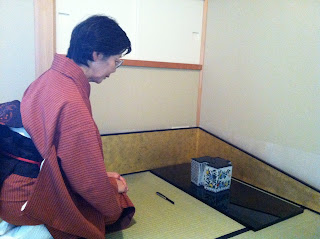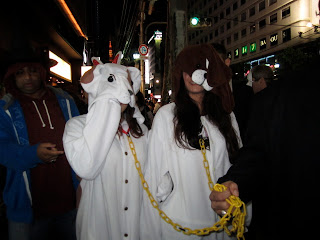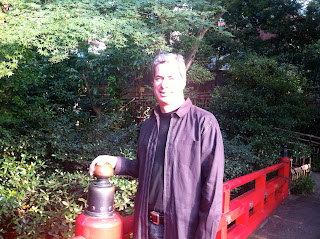We were all sitting in a classroom at TAC (the Tokyo American Club) while our teacher introduced us to the fine art of the Japanese tea ceremony, sharing a brief review of the history and explaining what we should expect in the actual tea ceremony which would take place at her own home. I had signed up for the class because a) tea ceremony was on my list of things I must do in Japan and b)getting invited to a Japanese person's home is like winning the lottery in America. It's nice to fantasize about, but it just doesn't happen.
Did you know that tea was introduced to the Japanese by a zen priest in 1191? Me either. It came from China. I thought tea came from Japan. In those days only the very wealthy could actually afford tea and tea ceremonies were devised as a way to display one's wealth. Shoguns, warlords, and the aristocracy would invite their friends, and enemies, over to show off, serving the rare and expensive tea in even rarer and more expensive tea cups, along with elaborate meals on the finest handmade plates, kind of like an American dinner party. "Where ever did you find these delightful dessert plates, they're beautiful!" Gloating smile, hidden beneath demurely lowered hostess's lashes. Points scored!
But in the 1500s a tea master named Sen Rikyu put an end to the debauchery and developed the "perfectly refined tea ceremony" called Cha-no-yu which means "the way of the tea." This became the standard upon which tea ceremonies are based today. His opinion was that the tea ceremony should not be used as a way to humble your friends and enemies but as a way to achieve the four virtues:
Harmony
Respect
Purity
Tranquility
He was quoted as saying:
"Though you wipe your hands and brush off the dust and dirt from the vessels, what is the use of all this fuss if the heart is still impure?"[10] (thank you Wikipedia)
Sen Rikyu prescribed that the tea ceremony should take place in a proper tea house. A house so tiny that guests have to sit close together and not be allowed to distance themselves from one another by rank or birth. The opening should be low so all guests, prince or pauper, have to bow to enter. To achieve the effect of tranquility the tea house should be set in a garden where guests meander through before entering, purifying themselves at the cistern before bowing to gain entrance.
Proper attention and respect should be given to appreciate the thoughtfulness and consideration of the host's preparation efforts of the tea ceremony. Each guest taking care not to step on the seams of the four and a half tatami mats as they pause for the appropriate amount of time to admire the carefully selected scroll, ikebana (flower arrangement), water vessel and iron tea pot, right down to the placement of the hand arranged coals the pot is steaming over.
Sounds good to me. When do we get to drink the tea?
The sensei told us we would be doing a lot of bowing and sitting on our knees so it would be best if we wore something that covered our knees. She also suggested we not wear any long necklaces or rings that could end up in the tea, or worse, possibly break one of the heirloom tea vessels.
She went on to explain, in great detail, the ritualized process of the actual tea making and subsequent tea drinking. How... we're supposed to bow when she enters, and bow when she offers us the token sweet. How we can't eat the sweet until she puts the macha (powdered green tea) into our cup, and then bow again when she gives us the tea, rest the tea cup on our left palm while supporting it with our right hand, turn the cup clock wise two turns so the front of the cup is now facing away from us, (what if there's no pattern?). Take a first sip, bow in appreciation. Take two more sips, and then on sip number four, slurp ostentatiously and finish the rest. Then carefully wipe the rim with a special paper napkin, then slowly, almost lovingly, admire the cup, making sure to keep our elbows on our knees so that our hands are low. Keeping the cup low ensures against breakage if the unthinkable were to happen. Yikes!!! Then humbly put the cup down and bow again. I'm not going to remember all that!
At the end of the class, I'd taken two whole pages (front and back) of notes, including note to self: take a Xanax beforehand. Actually, I don't have any Xanax. Hmmmm. Where can I get some?
Even though this was a class, and I was paying good American money Russell had earned to take it, I still insisted on bringing a hostess gift. I was going to someone's house after all and you never go to someone's home empty-handed. I might be learning Japanese customs, but I sure wasn't going to ignore my own. I brought a beautifully packaged box of sweets, the kind you use at tea ceremonies, as well as, some of those special paper napkins. Our teacher had shown us several examples in class and mentioned that napkins with the Chinese zodiac were very popular. We are currently in the year of the Rabbit and she had shown us her very own Rabbit embossed napkins. Next year is the year of the Dragon, serendipitously, I was born in the year of the Dragon, so I brought her a package of Dragon embossed napkins too.
The day of the tea ceremony arrived. It took me twenty minutes to determine an appropriate outfit to wear. I don't own a kimono and I had to cover my knees and one was expected to be demure and I wasn't supposed to wear jewelry. What was I missing? Oh yeah, the Xanax. Five outfits later I exited the apartment in black slacks, black socks and boots, having confirmed there were no holes in my socks because assuredly I would be required to remove my shoes in a Japanese home, a grey and black top with long sleeves and a high neckline and no jewelry. Well, except for my rings and earrings. Hey, I'm a pretentious American!
Our host's apartment was in a fashionable building in a fashionable part of Tokyo. It had three bedrooms and two bathrooms, a decent size kitchen and nice size living room, of which a portion had, at our hosts expense, been converted into a traditional tea room. The apartment was huge by Japanese standards, extravagantly large for one, older, tiny Japanese woman who lives by herself. She explained it was a fraction the size of the home she had lived in with her family in Kichijoji. That house had been seven times larger. There was a respectful silence as our host humbly explained she needed the extra room to house the over 4,000 tea ceremony utensils she owned, as well as, the over 2,000 kimonos she had. I don't own that many of anything.
Since no one else in my group had brought a gift, I waited for an appropriate time when our host was in the kitchen alone, to first, offer any assistance, and second, hand her the gift. It was then that I began to understand the whole Japanese appreciation thing. You would of thought I brought her a $30,000 kimono, by her delighted outburst when I presented the gift, the way she carefully observed the packaging, commenting on the loveliness of the bag, the wrapping, the inner wrapping and finally each seemingly exquisite piece of sweet. When I told her there was one more thing in the bag, I thought she was going to faint. They were just napkins but she fussed over them like new born kittens. My feathers were so pumped up by the time she was finished I could have flown into the other room.
I was so nervous about the tea ceremony I hardly ate any of the delicious lunch our host had prepared. She served sushi in a beautiful bowl. She explained that "sushi" doesn't mean fish necessarily. That "sushi" in fact literally means "vinegared rice" and can be served with most anything. This sushi was served with ground chicken, lotus root, green beans and seaweed. It was delicious. In addition to that, she had hand-made dumplings served with hand-shredded cabbage and a savory/sweet carrot sauce.
The "sushi" and hand-cut shredded cabbage.
Russell don't expect this at home.
Hand-shredded cabbage - who does that!? Apparently her help. She had an assistant who had insisted on cutting the cabbage herself. Even our host admitted she would have used a food processor.
She also had apples cut to look like rabbits, as well as, persimmons, which are in season right now. She explained that it's customary for Japanese mothers to go out of their way to make the bento box lunch for their kids very appealing. That often, fruit is cut into the shapes of animals and flowers for the enjoyment of the children.
This is an understatement. My friend Nancy took a Japanese Bento Box cooking class and it was explained to her, in no uncertain terms, that the Japanese children's bento box is a highly competitive undertaking. Japanese mothers are expected to provide artfully crafted bento boxes or their kids will be ostracized by the other children. The grocery store has an entire isle dedicated to this, with molds and accessories to assist the diligent mother. I'm not joking. Russell and I were there last weekend ogling the goods.
Our host told us about one of the first times she came to America to visit a friend. When she saw her friend in the kitchen beginning to prepare her kids lunch, she offered to help. Our host was well prepared to help as she has children of her own. Where do we begin? "Well," her friend said, "you can start by grabbing that butter knife and slathering some peanut butter on the bread." Our host was horrified when she realized that lunch meant a peanut butter and jelly sandwich and a bag of chips thrown into a brown paper bag!!! Not even the crust had been cut off. Oh, the humanity! But then she said, "I love peanut butter sandwiches and Cape Cod chips!"
After lunch, our tea ceremony commenced. She patiently demonstrated the appropriate pilgrimage we were to exhibit in the tea room. We took turns pretending we remembered everything she said. She graciously watched us make asses of ourselves and then she retracted behind the sochi screen, waited a few moments, then re-emerged as our tea master. It was amazing to witness the graceful and purposeful way she performed each step. Just carrying in the cups was like watching a finely choreographed ballet, each movement fluid and serene, like Fall leaves floating over river rocks smoothed by centuries.
Our host displaying the proper way to appreciate the scroll and flowers.
In this case the scroll was of Mt. Fuji and the flowers a perfect representation of Fall.
Where in hell did she find that perfect stem of maple leaves? Not only does it have two flawless, vermilion maple leaves, but a maple seed too. A seed! Plus a twig of wild chrysanthemum flowers which only grow this time of year.
And I thought my parties were well thought out.
Proper observation of the water vessel.
My knees hurt just looking at her.
That's the tea pot and the tray of sweets.
She actually used the sweets I brought!
Our hostess entering the tea room.
Any taller and she wouldn't fit behind that sochi screen!
It was clear she had carefully chosen each cup and utensil especially for us. In formal tea ceremonies all the guests drink from the same cup, after ritualized cleaning of course. But she recognized the propensity for Expats to be germ-a-phobic and had selected four individual tea cups. In formal tea ceremonies you're not really supposed to talk until after the first cup of tea has been served, but since this was a class we were allowed to ask questions during the entire process. I understood all of her cup choices except one. The first cup, represented us because, very unusually, it had an American flag painted on it, the third cup represented Japan. It was the traditional blue and white porcelain china hand painted with trees. The fourth cup represented the current zodiac because it had a rabbit on it. The second cup was plain white. She smiled a secret, knowing, smile when I commented on the cup selection, vocalizing what I had deduced. When I asked her about the white cup, her smile broadened as she said, "well that's your cup, you'll understand when it comes to you."
I should have captured this on video.
It was poetic.
Yeah, she's putting the tea in the cup.
I can eat my sweet.
The America's Cup
I was second in line and nervous as hell. No pressure! What if I don't get it? Oh my God, I'll look like a total idiot. And my legs were killing me. I can't sit like this much longer. HELP! May I have wine in my cup instead? The woman next to me has such great posture. I look like the hunch back of Notre Dame. I feel a foot cramp coming on. UGH! After the fourth drink and intentionally obstreperous final slurp, I understood. I smiled a ridiculously relieved, comic, clearly goofy smile, all I needed was to start drooling. At the bottom of my all white cup was a red circle. My cup represented Japan. Japan's flag being a red circle set on a white field. She nodded in pleased approval. I do strive to be the teacher's pet.
My cup, appropriately slurped.
I get it, I get it. Thank God!
But these cups meant much more than just America and Japan. She told us the story of how her father was one of the very first Japanese to be sent to America by the Japanese government. He was sent to America to learn how computers were being used for the stock market. Several "sayonara" parties were thrown in his honor. One was a formal tea ceremony given by one of the most renown tea masters in the country. He had artists custom make two cups in honor of her father's trip. One cup represented America and the other Japan. I think our faces turned as white as the Japan cup as we realized she was allowing us to handle these personal artifacts. I almost swallowed my tongue.
The funny thing is, she went on to say, at that time there were only 48 states in the United States. Sure enough, we discovered there were only 48 hand painted stars on the flag on the cup and because there were only 48, all the stars were in alignment in neat rows. Once the two other states were added, the stars on our flag had to be staggered to fit.
The next cup was the white porcelain cup painted with blue trees. She explained the trees were the three happiest trees. Happiest trees? I've heard of "happy plants" can you say cannibas? Who knew. The three happy trees are, why of course, plum, pine and bamboo. This cup represented her wish for our happiness. Wow, this is deep even without the cannibas.
The third cup with the happy trees.
The fourth and final cup represented more than just the current zodiac. It had several meanings. In addition to the rabbit, the cup was adorned with red berries. The Japanese word for the berries had two names which of course I can't pronounce. One meaning meant the berry, the other meant to change from something bad to something good. She explained it was popular to use a cup with these berries at the end of the year because a) they only grow in the later months of the year and b) and more importantly, it signifies turning from one year to the next and possibly from a difficult year to a better one. So in a way, she was wishing us a better year next year. After this last year with the Earthquake and the Tsunami, that word means even more.
At the end of the tea ceremony we all kind of sat in stunned, appreciative silence. Mostly for the grace and thoughtfulness of our host but also for our companion Linda who had somehow managed to stay sitting on her knees the entire time. When we asked her how she did it she humbly admitted, "I can't feel my feet. I think I'm going to have to just roll out of the tea room or be forcibly removed."
This ikebana (traditional Japanese flower arrangement) was in the entry way.
Even her entry way was poetic.















































